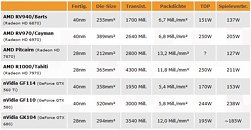Wednesday, March 14th 2012

GK104 Transistor Count and Exact Die-Size Revealed
A part of the reason why NVIDIA's performance-segment GK104 is gunning for the performance crown from AMD's Tahiti GPU could be hidden behind two of its key specifications: transistor count, and die-size. 3DCenter.org compiled these two specifications for the GK104 from reliable sources, which pin the transistor count at 3.54 billion, and die-area at 294 mm². This yields a transistor density of 12 million per mm², which is slightly higher than that of AMD Tahiti, slightly lower than that of AMD Pitcairn, and certainly higher than previous-generation chips from both AMD and NVIDIA. If GeForce GTX 680 does in fact end up competitive with AMD's Radeon HD 7900 series, it could serve as a tell-tale sign of NVIDIA's Kepler architecture being a more efficient one.
Source:
3DCenter.org

17 Comments on GK104 Transistor Count and Exact Die-Size Revealed
If only GK104 was to be priced in terms of die size instead of absolute performance compared to the competition :(
thats an over statement, cuz as far as GCN is concerned, the most efficient chip is the pitcairn
tahiti on the other side is a disapointment when u compare it with pitcairn, which has 40% more cores yet performs barely 20% better
considering both are the same architecture it means tahiti is bottlenecked somehow, or amd is holding something up its sleeve
Likewise, nVidia's designs in the past seemingly have had more ROPs, and do tend to perform better than their AMD counterparts. This new GPU from nVidia is very exciting, as everything seems ot indicate its' soemthing quite different from their previous designs, and seemingly, is about to kill AMD's ROP-starved 7970.
I still think AMD can beat Kepler by releasing two cards:
1. Overclocked HD7870, 1200MHz Core and 6000MHz Memory
2. Overclocked HD7970, 1200MHz Core, 7000MHz Memory(get 7GT memory already!)
The overclocked HD7870 would actually near Stock HD7970, i.e. GTX680, while being a hell lot cheaper and smaller to produce as well.
The overclocked HD7970 would smoke the GTX680, albeit in Fermi Style, with more power consumption
You know what I think, I've said it plenty of times. It's not ROPs the problem of the HD7970. Too much effort to decouple them from MC, just to be able to use 32 ROP and 384 bit and everything just to let it be a huge bottleneck? No sir.
Btw, any news about the mid range/Mainstream Kepler offerings ? With the low TDP it has, I'm very interested on how the little players will perform.And shoot their own legs in the process, damaging the sales of the 7950.
EDIT: a Evga GTX580 is now $430 on the egg.
Galaxy has one with an after-market cooler for $400.